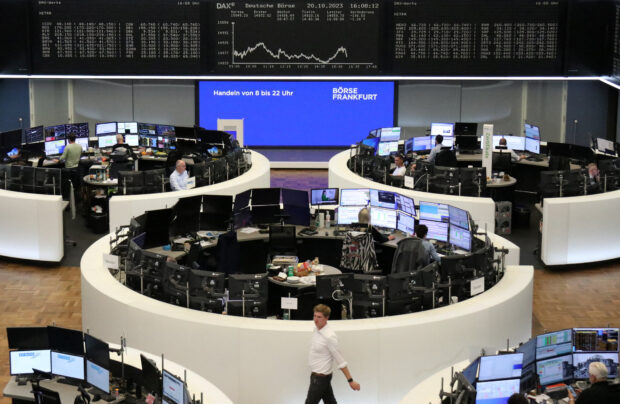10-year Treasury yield hits 5%, stocks at seven-month lows

The German share price index DAX graph is pictured at the stock exchange in Frankfurt, Germany, Oct 20, 2023. REUTERS/Staff/File photo
LONDON/SYDNEY – The benchmark 10-year Treasury yield rose above 5 percent and to its highest since 2007 on Monday, as a roaring U.S. economy led investors to expect interest rates to stay high for an extended period.
The combination of those higher yields and risk of a wider conflict in the Middle East soured sentiment at the start of a week full of mega-cap earnings and key data, and pushed global shares down to seven-month lows.
The 10-year Treasury yield reached 5.012 percent, and was last up 8.6 basis points on the day, the latest sign of the scale of the global bond sell off, driven also by rising government debt increasing supply of bonds around the world.
“5 percent from an economic perspective is just another number. But as far as investors are concerned it resonates,” Daiwa Capital chief economist Chris Scicluna said.
“I don’t think it’s a tipping point, but it’s a reminder of the record tightening we’ve had and it’s a reminder, as far as the Fed is concerned, that they can’t be entirely sure quite how much of that tightening so far has already been transmitted to the real economy and how much more is to come,” he said.
READ: U.S. 10-year Treasury yields hits 5% for first time since 2007
The recent surge in bond yields has tightened monetary conditions without the central banks having to do anything, allowing the Federal Reserve to signal it will likely stay on hold at its policy meeting next week.
Indeed, futures imply around a 70-percent chance the Fed is done with tightening for this cycle and are flirting with the chance of rate cuts from May next year.
The jump has also challenged equity valuations and dragged most major indices lower last week, while the VIX “fear index” of U.S. stock market volatility hit its highest since March.
The MSCI All-World index was last down 0.2 percent, at its lowest since late March, when turmoil that had gripped the global banking sector started to subside.
In Europe, the STOXX 600 was down 0.5 percent, also at seven-month lows, and rate-sensitive real estate stocks dropped to their lowest since 2012.
U.S. index futures were last down around 0.5 percent.
READ: Wall Street struggles as war worries collide with hope for stronger profits
The war in the Middle East was also high on investors’ minds. Washington warned over the weekend of a significant risk to U.S. interests in the Middle East as ally Israel pounded Gaza and clashes on its border with Lebanon intensified.
Growth surge
Mega caps Microsoft, Alphabet, Amazon and Meta Platforms all report earnings this week. IBM and Intel are also on the docket.
Profits should be supported by the strength of consumer demand with figures on U.S. gross domestic product this week expected to show annualized growth of a heady 4.2 percent in the third quarter, and nominal annualized growth possibly as high as 7 percent.
This U.S. outperformance has underpinned the dollar, though the threat of Japanese intervention has capped it at around 150.00 yen, at least for the moment. The dollar was last trading at 149.93 yen, just below the recent peak of 150.16.
Yields in Japan were also on the rise on speculation the Bank of Japan was discussing a further tweak to its yield curve control policy, which might be announced at its policy meeting on Oct. 31.
The euro rose 0.17 percent to $1.0613, while the Swiss franc, which has benefited from safe-haven flows over the past couple of weeks, held steady at 0.8928 per dollar, and was a touch weaker on the common currency at 0.94715 per euro.
The ECB meets later this week and is fully expected to leave interest rates unchanged at 4 percent. Investors will be looking for any kind of signal from ECB President Christine Lagarde about how the recent rise in global bond yields might affect the outlook for euro zone monetary policy.
“Given the further up-shift in yields we’ve had of late, the geopolitical events since the last meeting, I think we’ll want to wait and see what her tone is and whether she’s still got a tightening bias at the margin,” Daiwa’s Scicluna said.
Gold, which hit its highest since May last week thanks also to safe-haven inflows, was flat at $1,980 an ounce.
Oil prices recovered from earlier losses, with investors continuing to focus on the situation in the Middle East.
Brent crude was flat at to $92.21 a barrel, while U.S. crude was at $87.97.